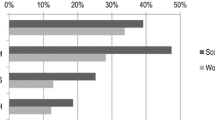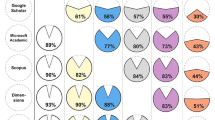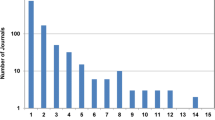Abstract
Citation time series are not easy to compile from the most popular databases. The Data for Research service of the JSTOR journal database is a large and high-quality sample of citations, weighted towards humanities and social sciences. It provides time series citation data over many decades, back to the origins of the constituent journals. The citation trajectories of Nobel Prize winners in economics are analyzed here from 1930 to 2005. They are described mathematically by means of the Bass model of the diffusion of innovations. A bell-shaped curve provides a good fit with most prize winner citation trajectories, and suggests that economic knowledge follows the typical innovation cycle of adoption, peak, and decline within scholarly careers and shortly afterwards. Several variant trajectories are described.







Similar content being viewed by others
Notes
An inspection of publication trends for each of JSTOR’s relevant subject areas suggests that all fields followed a similar growth trend during our period; it is unlikely that deflating by the total number of articles distorted the data in any particular direction.
As one of them told us.
References
Alexander, J., & Mabry, R. (1994). Relative significance of journals, authors, and articles cited in financial research. The Journal of Finance, 49(2), 697–712.
Anderson, G., & Levy, D. T. (1989). The half-life of dead economists. The Canadian Journal of Economics, 22(1), 174–183.
Archambault, E., Vignola-Gagne, E., Cote, G., Vincent, L., & Gingras, Y. (2006). Benchmarking scientific output in the social science and humanities: the limits of existing databases. Scientometrics, 68(3), 329–342.
Bailey, N. (1957). The mathematical theory of epidemics. New York, NY: Hafner.
Bass, F. (1969). Product growth for model consumer durables. Management Science, 15(5), 215–227.
Blair, D., Cottle, R., & Wallace, M. (1986). Faculty ratings of major economics departments by citations: an extension. The American Economic Review, 76(1), 264–267.
Burns, J., Brenner, A., Kiser, K., Krot, M., Llewellyn, C., & Snyder, R. (2009). JSTOR—data for research. Research and Advanced Technology for Digital Libraries: Lecture Notes in Computer Science, 571, 416–419.
Chang, S.-B., Lai, K.-K., & Chang, S.-M. (2009). Exploratory technology diffusion and classification of business methods: using the patent citation network. Technological Forecasting and Social Change, 76, 107–117.
Daudin, G. (2011). Quantitative methods and economic history. In F. Ammannati (Ed.), Where is economic history going? Methods and prospects from the 13th to the 18th centuries. Firenze: Firenze University Press.
Davis, J. (1998). Problems in using the social science citation index to rank economics journals. The American Economist, 42(2), 59–64.
De Bellis, N. (2009). Bibliometrics and citation analysis: From the science citation index to cybermetrics. Lanham, MD: Scarecrow.
Diamond, A. (1984). Does Mandeville matter today? History of Economics Society Bulletin, 3, 189–196.
Diamond, A. (1988). Citations counts for Nobel Prize winners in economics. History of Economics Society Bulletin, 10(1), 67–70.
Dixon, R. (1980). Hybrid corn revisited. Econometrica, 48(6), 1451–1461.
Garfield, E. (1992). The 1991 Nobel Prize winners—from patch clamps (Neher and Sakmann) to spaghetti theory (de Gennes), social costs (Coase), and NMR (Ernst)—were all citation superstars. In Essays of an information scientist: Of Nobel class, women in science, citation classics, and other essays (vol. 15, p. 12).
Gorraiz, J., Gumpenberger, C., & Wieland, M. (2011). Galton 2011 revisited: a bibliometric journey in the footprints of a universal genius. Scientometrics, 88, 627–652.
Harzing, A.-W. (2011). The publish or Perish book: Your guide to effective and responsible citation analysis (1st ed.). Melbourne, VIC: Tarma Software Research Pty Ltd.
Hoover, K. D. (2012). Microfoundational programs. In P. G. L. Duarte & G. Tadeu (Eds.), Microfoundations reconsidered: The relationship of micro and macroeconomics in historical perspective (pp. 19–61). Cheltenham: Edward Elgar.
Kear, R., & Colbert-Lewis, D. (2011). Citation searching and bibliometric measures. College & Research Libraries News, 72(8), 470–474.
Kelly, M., & Bruestle, S. (2010). Trend of subjects published in economics journals 1969–2007. Economic Inquiry, 49(3), 658–673.
Lilien, G. L., & Rangaswamy, A. (1997). Marketing engineering: Computer-assisted marketing analysis and planning. Reading, MA: Addison-Wesley.
Liu, Y., & Rousseau, R. (2008). Definitions of time series in citation analysis with special attention to the h-index. Journal of Infometrics, 2, 202–210.
Mahajan, V., Muller, E., & Bass, F. (1990). New product diffusion models in marketing: a review and directions for research. Journal of Marketing, 54(1), 1–26.
Mahajan, V., & Peterson, R. (1985). Models for innovation diffusion. Beverly Hills, CA: Sage Publications, Inc.
Mahajan, V., & Sharma, S. (1986). A simple algebraic estimation procedure for innovation diffusion models. Technological Forecasting and Social Change, 30, 331–345.
Mahajan, V., & Wind, Y. (1985). Innovation diffusion models of new product acceptance: A reexamination. Working paper No. 85–038.
Meade, N., & Islam, T. (2006). Modelling and forecasting the diffusion of innovation—a 25-year review. International Journal of Forecasting, 22, 519–545.
Medoff, M. H. (1989). The ranking of economists. Journal of Economic Education, 20(4), 405–415.
Medoff, M. H. (1996). A citation-based analysis of economists and economics programs. The American Economist, 40(1), 46–59.
Pemberton, E. (1936). The curve of culture diffusion rate. American Sociological Review, 1(4), 547–556.
Radicchi, F., Fortunato, S., & Castellano, C. (2008). Universality of citation distributions: Toward an objective measure of scientific impact. Proceedings of the National Academy of Sciences, 105(45), 17268–17272.
Rogers, E. (1983). The diffusion of innovations. New York, NY: Free Press.
Schmittlein, D., & Mahajan, V. (1982). Maximum likelihood estimation for an innovation diffusion model of new product acceptance. Marketing Science Winter, 1, 57–78.
Schonfeld, R. C. (2003). JSTOR: A history. Princeton, NJ: Princeton University Press.
Skarbek, D. (2009). F. A. Hayek’s influence on Nobel Prize winners. Review of Austrian Economics, 22, 109–112.
Söderberg, G., Offer, A., & Bjork, S. (2013). Hayek’s citations and the Nobel Prize in economics. Part 1. Influences from Mises to Bartley. In R. Neeson (Ed.), Hayek: A collaborative biography. New York, NY: Palgrave.
Srinivasan, V., & Mason, C. (1986). Nonlinear least squares estimation of new product diffusion models. Marketing Science, 5(Spring), 169–178.
Stigler, G. (1969). Does economics have a useful past? History of Political Economy, 1, 217–230.
Sultan, F., Farley, J., & Lehmann, D. (1990). A meta-analysis of applications of diffusion models. Journal of Marketing Research, 27(1), 70–77.
Van Dalen, H. P. (1999). The golden age of Nobel economists. The American Economist, 43, 19–35.
Weinberg, B., & Galenson, D. (2005). Creative careers: The life cycles of Nobel Laureates in Economics. National Bureau of Economic Research, Working Paper p. 11799.
Acknowledgements
This project was supported by a grant from the Institute for New Economic Thinking (INET). Sundas Ali assisted ably in processing the data.
Author information
Authors and Affiliations
Corresponding author
Rights and permissions
About this article
Cite this article
Bjork, S., Offer, A. & Söderberg, G. Time series citation data: the Nobel Prize in economics. Scientometrics 98, 185–196 (2014). https://doi.org/10.1007/s11192-013-0989-5
Received:
Published:
Issue Date:
DOI: https://doi.org/10.1007/s11192-013-0989-5




